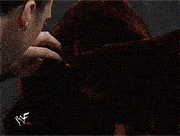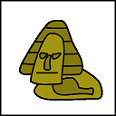|
Helianthus Annuus posted:can you identify these intervals by ear? internalizing the sound of each interval is much more important than instead of learning to read them from a score. https://www.musictheory.net/exercises/ear-interval  Oh god Iím really bad at this. I canít even identify octaves consistently. Iíve gotten rusty since my piano days. Oh god Iím really bad at this. I canít even identify octaves consistently. Iíve gotten rusty since my piano days.
|
|
|
|

|
| # ? Jun 7, 2024 16:16 |
|
I identified my first one! It was a unison!
|
|
|
|
Finding familiar songs and melodies that begin with a strong interval helped me, over the rainbow starts with an octave, shave and a haircut is a descending fourth and so on
|
|
|
|
Pollyanna posted:
its trainable! i used this one while riding the train to work: https://www.miles.be/software/ear-training-on-your-iphone-ipad-and-android/ The thing about this particular one: it trains you by first establishing a key center with a little piano chord progression (same one every time), then it plays a tone, and then you have to identify what scale degree that is! And when you pick the right one, it plays the part of the scale that leads it down to the key center (or up to the key center if it's faster to go up). So next time it comes up in training, you can "prove" to yourself which degree it is by singing the scale notes that lead back to the root. I guess this is supposed to reinforce your learning, too. After maybe a week of training with it, I was mostly getting 100% of the scale tones, but i stopped improving because the more advanced training has you identifying non-scale tones (a lot harder to do). Flinger posted:Finding familiar songs and melodies that begin with a strong interval helped me, over the rainbow starts with an octave, shave and a haircut is a descending fourth and so on same, i use "here comes the bride" for the ascending perfect 4th Helianthus Annuus fucked around with this message at 23:08 on Jun 29, 2022 |
|
|
|
Flinger posted:Finding familiar songs and melodies that begin with a strong interval helped me, over the rainbow starts with an octave, shave and a haircut is a descending fourth and so on I use Sabbath riffs and it works great haha
|
|
|
|
i used the rick beato interval trainer (donít buy it, too expensive) and after a few weeks i could easily identify all intervals, harmonic and melodic. just gotta brush up on it a few minutes a week. well worth the effort
|
|
|
|
Rocko Bonaparte posted:Can I get some recommendations on books with little assignments to keep me on task? I'd like to be able to do something generic for placeholders for video game stuff. If I had to pick a genre, then maybe classical (or epic classical?) vs anything like jazz, or blues. I can glean stuff from videos but I'd rather have something to lists out a topic for a bit and then urges me to do a 30-second something with it. That would at least give me something to post online and ask if I understood it at all. i just remembered something for you! years ago, i printed off a 100 page PDF called "Practical Theory Complete by Sandy Feldstein", and i put it in a binder. It has explanations and a quiz at the end of each lesson. i can find the pdf with the usual web search tools, but its also for sale from online retailers. maybe see if it covers what you want to learn? Helianthus Annuus fucked around with this message at 01:17 on Jun 30, 2022 |
|
|
|
That "Practical Theory Complete by Sandy Feldstein" is like The Da Vinci Code compared to this "Music Theory and Composition" book. It's so short with really short, satisfying chapters. I probably should have started there but I'm already slogging through this. What's pretty funny is that intervals are, like, prelude 4 of 6 preceding 56 chapters in this book where it's lesson 72 of 84 in Sandy's book. So I guess I would have fallen off of Sandy's book soon and needed something else anyways. I could also say I'm unsuitable for any book because I apparently can't read. What I missed in the thickass theory book was: quote:If the higher note in an interval belongs to the major scale of the lower note, then the interval will either be perfect or major. The minor intervals are mentioned in a pretty roundabout way too. I might have to take this as a warning shot on how this is going to go. I think this advanced book is in the very-pedantically-literally-correct-but-somehow-also-useless way of things like I talk after programming all day. I found something online just a bit ago that did a good job of reinforcing what I was supposed to do. What I've also figured out is I really suck at knowing what are my other scales and that's one I need to recover with the help of a keyboard. I still think it was bullshit the book listed out the examples with C as the base note and then the assignments switched it out. That's a dick move. Reminds me of my advanced engineering classes. Edit: Now with my space constraints, I have my controller off to the side out of reach from my computer where it can actually make sounds, so I have this urge to try to find something small I can plug it into for just screwing around. I see what's happening here. Before I make my big move I'm going to have 20 lovely, keyboard-less synthesizers and junk.
|
|
|
|
Rocko Bonaparte posted:That "Practical Theory Complete by Sandy Feldstein" is like The Da Vinci Code compared to this "Music Theory and Composition" book. It's so short with really short, satisfying chapters. I probably should have started there but I'm already slogging through this. What's pretty funny is that intervals are, like, prelude 4 of 6 preceding 56 chapters in this book where it's lesson 72 of 84 in Sandy's book. So I guess I would have fallen off of Sandy's book soon and needed something else anyways. the Stone book is terse. in the counterpoint chapters, i would often run into some problem and have to scour the chapter for the answer, usually given in a sentence or two. it definitely wants you to review a lot and potentially work with a teacher. it also seems to assume some basic theory knowledge - hence, the first chapters being "preludes". so, maybe i'm changing my tune - it might be better to work intervals, chord construction, scales and stuff before delving further into Stone. don't be discouraged if you hit a wall anywhere - it's taken me many years, and reinforcement from lots of different sources, to master even the basics of theory, including a couple college level theory classes.
|
|
|
|
i'm loving melodic minor right now. this book gave me a more nuanced understanding of why there are ascending / descending versions and when they should be used. it's a subtle difference, but he says "if your melody is approaching the tonic, use the ^6 and ^7. if you're approaching the 5th, use the b6 and b7." basically, it gives you the two nice tendency tones of leading tone -> tonic, and b6 -> 5 whenever it makes sense. and of course, no augmented 2nd leap. just jamming around with it sounds a lot like Bach to me
|
|
|
|
i'm way into lydian lately little bit "brighter" sounding than major but it's more ambiguous... that + darker lyrics gives you this incredible, almost sinister vibe, like you're being seduced or something
|
|
|
|
i'm a dorian man, myself it's very ethereal and other-worldly sounding
|
|
|
|
Phyrgian because metal for me
|
|
|
|
bltzn posted:i'm a dorian man, myself every time i'm playing in a minor key that natural 6 starts showing up all over the place. can't help it
|
|
|
|
Hey everyone, modal noob here reporting back I went back and brushed up over my basic theory so I'm feeling much better about tackling the modes. My question is this: So I know if I'm soloing over the chord progression G, C, D in G major, I play ionian over the G, C lydian over the C, and D mixolydian over the D. The problem I'm having is remembering the corresponding modes. It's easy over a simple chord progression like that, but when it comes to more complex chord progression I constantly find myself struggling over which mode to play over each key. Does anyone know of tricks/tips for this? Or is this just a brute force thing where I just gotta put in the time?
|
|
|
|
your thought of seeing the mode that fits each chord is a good one, and my goal isn't to derail you. HOWEVER... it's more important to think of the chord tones than a particular mode that you play over each chord. looking at your example, what notes do each of those modes contain? they all contain the notes of the G major scale: G A B C D E F#. the difference is what notes get emphasized, or, which note is the tonic. so you can think: "i'm playing in the G major scale, emphasizing G-B-D over the G, C-E-G over the C, and D-F#-A over the D." this way of thinking is faster for me, and you end up playing chord tones which will always sound good. having to think about a different mode for each chord is going to be too slow - and, you might end up just playing the scale up and down if you think this way, which will be boring. i found this video very helpful w/r/t chord tones and guide tones: https://www.youtube.com/watch?v=Dz_2C3-oI2o
|
|
|
|
a.p. dent posted:your thought of seeing the mode that fits each chord is a good one, and my goal isn't to derail you. HOWEVER... This was immensely helpful thank you! I think a lot of people were trying to tell me this or something similar, but it is finally clicking for me now that I've brushed up on my more basic theory. I think I get so lost in "which notes do I play" I completely ignore HOW I play them, which is equally as important. I'm definitely one of those "fingers are faster than my brain" players, but I'm slowly trying to remedy that!
|
|
|
|
Kvlt! posted:This was immensely helpful thank you! I think a lot of people were trying to tell me this or something similar, but it is finally clicking for me now that I've brushed up on my more basic theory. I think I get so lost in "which notes do I play" I completely ignore HOW I play them, which is equally as important. I'm definitely one of those "fingers are faster than my brain" players, but I'm slowly trying to remedy that! cheers, glad it was helpful! saw this on reddit and thought the thread might enjoy it: https://web.archive.org/web/20151118154144/http://www.submediant.com/2015/11/02/study-so-called-atonal-music-just-been-in-a-minor-all-along/
|
|
|
|
. . . maybe they just forgot to write down that it was in A-minor?
|
|
|
|
I'm doing a musical sort of thing and have very limited musical experience/talent/ear. I was hoping you all might have some good ideas for me. As part of an escape room game I'm doing for friends, one segment will involve a short sequence of notes being played, and players having to recreate the sequence on a keyboard-ish thing. Naturally what inspired this was "Close Encounters of the Third Kind" (ie. this scene) - and I'll use those 5 tones for one of the sequences (G1 A1 F1 F0 C1). But I'm looking for some more short (5-7 notes or so?), possibly (but not necessarily) recognizable sequences that'll be fun for players to do. Any ideas?
|
|
|
|
jmzero posted:I'm doing a musical sort of thing and have very limited musical experience/talent/ear. I was hoping you all might have some good ideas for me. For recognizable melodies, "Mary Had a Little Lamb" or something? If you want it to be non-recognizable, there are a lot more options for you than I can enumerate, but some melodies are more "singable" than others. One thing I want to mention: in music, the sequence of notes is only part of the story, the rhythm is also important. But requiring correct rhythm could make your puzzle too hard. Maybe it could be cool to give your players some feedback about their guesses, something like they do in the game Mastermind? https://en.wikipedia.org/wiki/Mastermind_(board_game)
|
|
|
|
A lot of this is knowing your audience, this is almost more of a pop culture problem than a musical one. Final Fantasy VII has a puzzle like that and uses the airship theme from the game for the solution, and the Star Trek theme has a couple riffs that show up across series. The band Phish does a few of these as part of their live show as crowd signals, that 'circus' riff (I'm sure you know what I mean) and the simpsons theme work the best imo (and the Star Trek theme too sometimes actually). Chopsticks (piano) or Smoke On The Water (guitar/bass but you'll recognize it on keys) are like very basic beginner repertoire things if you wanted to go that direction. Helianthus Annuus posted:For recognizable melodies, "Mary Had a Little Lamb" or something? If you want it to be non-recognizable, there are a lot more options for you than I can enumerate, but some melodies are more "singable" than others. Yeah, I'd try to give a lot of leeway on the rhythm (and also octave, MIDI is weird about what number middle C is sometimes) unless you specifically wanna make it a musical challenge
|
|
|
|
jmzero posted:I'm doing a musical sort of thing and have very limited musical experience/talent/ear. I was hoping you all might have some good ideas for me. recreate that scene from Amadeus by using Eine Kleine Nachtmusik
|
|
|
|
Some great ideas (and other thoughts) - got a few things I'll try. Thanks!
|
|
|
|
The Addams Family theme is a fun one most people know
|
|
|
|
Given how bizarro associative escape rooms get, you can try to make a little song using music notes and have that word somewhere. Apparently, there's a whole thing in Germanic cultures to represent a B as an H while a Bb is a B, so you can do poo poo like "headache" or "beached" with some clues. I seem to wind up with the escape rooms that are a little nuts.
|
|
|
jmzero posted:Some great ideas (and other thoughts) - got a few things I'll try. Thanks! I think if you follow basic part writing "rules", then everything should be fairly familiar. Like, do stepwise motion, or if you leap up, resolve down by step, if you leap down, resolve up by step. When I say by step, I mean whatever the next diatonic degree is. So if you lept from C to A, resolve it to G. Also keep it mostly diatonic I agree rhythm adds complexity to your microcontroller or plc code. Otherwise, fairly simple to implement if it's just an order where wrong note=restart. You could also alert the player to these states or let them just stumble across the winning condition the first time they get it keyed in.
|
|
|
|
|
Use the music from the Bone Organ scene in Goonies
|
|
|
|
Basic Poster posted:I agree rhythm adds complexity to your microcontroller or plc code. Otherwise, fairly simple to implement if it's just an order where wrong note=restart. You could also alert the player to these states or let them just stumble across the winning condition the first time they get it keyed in. This part is intended to be more of a fun gimmick than a real challenge - so I'll give them immediate feedback as they hit correct/wrong notes (I have a variety of lights/displays available). I won't be tight on rhythm, but I might have a "timeout" once a sequence has started. Probably have them go through a few sequences, getting harder over time. quote:Use the music from the Bone Organ scene in Goonies I went back and watched that - I'm sure I saw Goonies in the theaters, but not since. Fun bit of nostalgia. Unfortunately, scene doesn't actually contain a usable tune  quote:The Addams Family theme is a fun one most people know Man... now I kind of want to do that - and force two players by having a separate button (placed at a distance) for someone to make the "snaps". Anywho, I've got the technical parts I wasn't sure about going (a Teensy to connect the keys up to USB, and I've got a software synthesizer that plays notes reasonably) - so now I'll mess around with some different tunes/setups. jmzero fucked around with this message at 21:01 on Jul 9, 2022 |
|
|
|
I just took my first stab at the staff view in Cakewalk and was really frustrated. I've done a stuff in ancient Windows music notation editors that were more intuitive than this. I suspect there's a kind of Skinner Box thing here where I'll just get the vibe after some time and problems won't happen any more, but I don't know if it's worth it. I'm willing to put down some bucks if it'll get me an editor that is less frustrating. What I was trying to do was just lay out some triads in their different forms and inversions and play them a bit to get more comfortable with them. I tried to lay out some quarter notes in the first measure, and it seemed fine at first, but it kept putting in a quarter rest right after it and I could only add more quarter notes after that rest. Subsequent measures were fine... except if I clicked a little bit left or right, I'd get some moonbeam timing on the note; it was trying to playing it at some tight offset from a straightforward quarter-note position. To sharpen or flatten a note, I had to right click the note and change it in the ensuing dialog box. I figured there'd be a shortcut or something right in the GUI. The manual I found online implied the GUI was the normal means. Between this GUI and God-knows-what, I would find in playback afterwards that the notes in the chords weren't always actually playing together. Like, stuff would just hit at slightly different times despite no goofy things in the notation. The more I played with it, the less that all happened, but sharpening and flattening being as they are is still a pain in the rear end. Is there anything else I can use that supports VST and could be put on two machines here for some hobbyist stuff? Comedy option: Record off a loving keyboard like an adult, but I am imagining the staff view will be a toxic waste dump trying to fit the timings too precisely to my ham-fisted volleys.
|
|
|
|
Initial self-response: I managed to bring up Edit: I can't say Edit 2: Try as I might, I just can't remember to call it "MuseScore." Rocko Bonaparte fucked around with this message at 20:55 on Jul 11, 2022 |
|
|
|
Rocko Bonaparte posted:Initial self-response: I managed to bring up MusicScore 3 with a MIDI loopback into Cakewalk, but I had to restart once to get the loopback driver fully connected and Cakewalk had a few false starts before it actually worked. Basically, MusicScore acts like a MIDI source when it plays music and Cakewalk just blasts it out like it's live. The main frustration was seeing Cakewalk detecting the MIDI notes in its keyboard view but not getting any audio. MIDI echo was enabled and it even looked like digital mixing was fine. I never really figured it out; I just restarted Cakewalk one more time and it just started working. i don't think i can help you, but are you referring to MuseScore? i use that for notating stuff and it's decent, but that's all i use it for
|
|
|
|
You're right. I just can't, for the life of me, type that for some reason. I must be hitting an age now where I'll start calling the Internet "The Yahoo."
|
|
|
|
Oh man Cakewalk staff view was my first stab at notation programs and it was real bad. In fairness, this was like......1998 but based on your description it's just as bad. drat you HA for linking 8-bit Music Theory because I've been watching his videos all day instead of doing the grad school homework I was supposed to do. Two theory classes in this grad degree; the first one was basically a 6-week overview of classical music theory culminating in an academic analysis article where I had to tear a piece of music apart and describe what was going on theory-wise in a narrative way. Kind of like what 8-bit does in his videos actually, except I had to source things and write all fancy. Did not like. The class I'm taking now though is cool af since instead of college level theory it's like, ok you know college theory, now how do you make middle schoolers want to learn your dumb college-level theory (hence the getting sidetracked by 8-bit MT videos, which I am absolutely going to use for lesson plans). Anyway one of our readings this week was from this book: https://www.amazon.com/Music-Theory-Remixed-Approach-Practicing/dp/0199330565 and I'm probably going to buy it because it was a great read and had some awesome prompts for composing at the end of the chapter. Thought y'all might be interested in it too. Dude did a few music theory videos to accompany the book too which look cool: https://www.youtube.com/user/TrevorTwiggenVIII I've only watched the Queen one but it was neat. I want his clear whiteboard thing real bad.
|
|
|
|
At Least It's Not Finale
|
|
|
|
I had some more trouble with Cakewalk last night. I had unwittingly copied a VST2 plugin to my C:\Program Files\Common Files\VST3" folder and wondered why it wouldn't show up. I eventually had to make a different folder for it and it scanned fine. I just thought it was really counter-intuitive. How does the UX compare with some of the other DAWs? I had also tried to copy the Spitfire LABS files from my other machine over and that was a comedy of failure, but I chalk that up to all that proprietary stuff LABS is doing. I'm pretty bummed I can't just directly copy that off of a computer next to me. Edit: I guess I can just ask that elsewhere in other threads but I think the angle of "trying to run sheet music through a VST" is particular to here.
|
|
|
|
for getting sheet music to VST, have you tried creating "Parts" in musescore and exporting them to MIDI? that's what's recommended here: https://musescore.org/en/node/291514. unfortunately that's a lot of steps and you can't play with it live. this is why i don't use computers for music, despite being a computer programmer. poo poo sucks.
|
|
|
|
a.p. dent posted:for getting sheet music to VST, have you tried creating "Parts" in musescore and exporting them to MIDI? that's what's recommended here: https://musescore.org/en/node/291514. unfortunately that's a lot of steps and you can't play with it live. yep, music comp class where i had to write in notation was frustrating as hell, because 90% of the time i wasnít writing music or learning to composeó i was dicking around with sibelius, trying desperately to get it and garriten instant orchestra to work together.
|
|
|
|
reading The Jazz Theory Book (Mark Levine) and it's helping melodic minor in a jazz context make sense. the key thing is that it has no avoid notes over certain types of chords, and thus can be substituted over lots of different, interesting chords. example: usually the first scale we'd use over a G7 is G Mixolydian, but that contains a natural 4 - it clashes with the 3. Lydian Dominant (4th mode of melodic minor, Mixolydian with a #4), on the other hand, has no avoid notes, so you don't need to think as much. same goes for altered chords (7th mode of mm.), Maj#5 chords (3rd mode, Lydian Augmented), and some others i don't quite get yet. he talks about a "susb9" chord a lot and i really haven't encountered that one. pretty cool stuff - i need to get a piano to play his examples easier because many of the chords are impossible on guitar
|
|
|
|

|
| # ? Jun 7, 2024 16:16 |
|
Update on my modal guitar progression (and please tell me to stop if these are annoying). It really struck me when someone itt said "focus more on the notes your EMPHASIZING modally". So I took the jam section of one of my favorite songs to solo to (Tweezer by Phish), realized I didn't wanna start on a song that has minor 7ths, and just picked a simple A > D chord progression to solo over. So assuming we're in the key of A, I played simple A ionian over the A chord. Then I looked at D and thought "Okay, let's play some D mixolydian". D mixo and A major share the notes A, B, D, E and F# So over the D, I would play those notes or try to emphasize those notes with my phrasing, and wow it really opened up my playing! It also increased the fun factor too, because I felt like I was using my brain as well as my fingers. My question, how do I apply modes to minor keys? I tried to do Am > Dm. So If I'm in the key of A minor, then the Dm is also the 4th, but mixolydian is a major mode, so it doesn't make sense to play a major mode over a minor chord (or does it? Maybe I'm misunderstanding) So what would I do in the context of applying modes to soloing in minor keys? Thank you again as always for all the help!
|
|
|



















